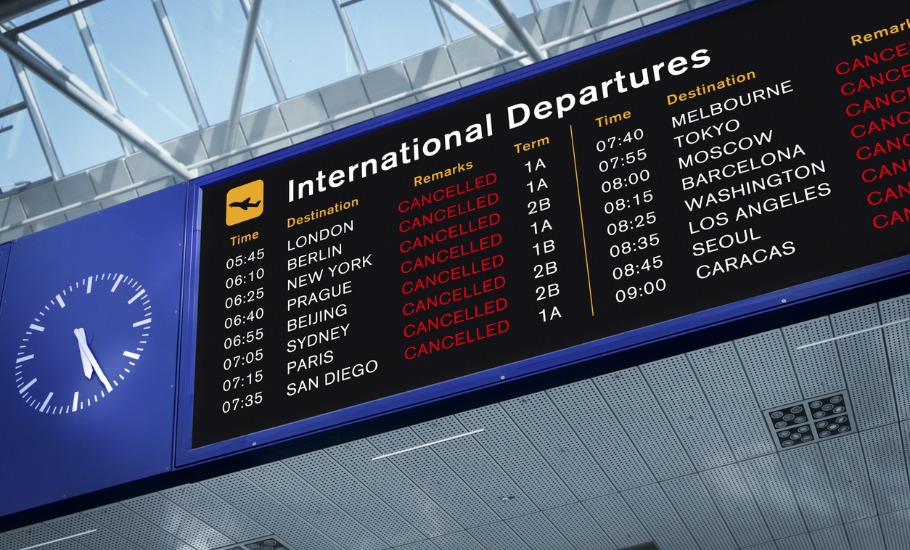
COVID-19 lockdown: Two-third flights cancelled; 66% planes sit on tarmac
Following lockdowns in view of the coronavirus outbreak, more than two-thirds of international flights have been cancelled or left in-operative until March 6 while the decline in operations started three months ago in January.

Following lockdowns in several countries across the globe in view of the coronavirus outbreak, more than two-thirds of international flights have been cancelled or left in-operative until March 6 while the decline in operations started three months ago in January.
However, cargo traffic, some commercial flights, and humanitarian carriers (flights sent by the United Nations to various countries carrying medical aid) are still operating to help people stranded in different parts of the world.
As on January 6, around 1.84 lakh flights used to depart from across the world on a daily basis while the number, over a period of three months, plunged to 61,570 departures (as of March 6).
Meanwhile, the actual reduction in air traffic was observed since March 11 which came five days (March 6) after the global COVID-19 count crossed one lakh cases.
This decline, which approximately accounts for about 66 per cent of the sudden drop in international air traffic, comes as a result of the travel restrictions imposed across the world.
While many countries resorted to a total ban on international passenger flights, some have placed restrictions on travellers from specific regions.
Travel bans as per countries
As per an Al Jazeera report, of the 201 countries, which are under some form of lockdown, 77 countries have imposed a complete ban on international passenger carriers, 67 opted for a partial ban, and there is no clear data for the remaining 57 countries on the kind of restrictions placed on air travel.
A complete ban on air traffic refers to restriction on entry of foreigners, suspension of all international flights other than those carrying citizens stranded in other parts of the world or permanent residents of the country. While partial ban means the international carriers are in operation, however, with restrictions such as ban on flights from specific countries or travellers from certain destinations.
Related news: COVID-19 sounds May day for airlines, companies to lose ₹1,700 crore
Even as these restrictions are mainly imposed on air travel, some countries decided to seal their water and land borders as well.
Interestingly, of the ten countries that are worst-hit by the coronavirus pandemic, only two of them have imposed a complete ban on international air travel.
While Spain and Switzerland have announced total restrictions on entry or departure of international carriers, the United States of America, Italy, Germany, France, China, Iran, United Kingdom, and Turkey have put a partial ban on air travel.
Among other prominent countries, India and gulf nations, excluding Qatar and Bahrain have also imposed complete bans on all international flights.
According to data given by Flightradar24, on an average, the number of departures have dropped down from 1.68 lakh flights per week to just 72,000 in seven days.
WHO against travel ban
However, contradictory to the restrictions placed by these countries, the World Health Organisation (WHO) in its recommendations said that travel bans are usually ineffective in preventing the import of cases in COVID-19 like situations.
“WHO continues to advise against the application of travel or trade restrictions to countries experiencing COVID-19 outbreaks. In general, evidence shows that restricting the movement of people and goods during public health emergencies is ineffective in most situations and may divert resources from other interventions,” the guidelines updated on February 29 for international travel restrictions stated.
Reduced carbon emission
The dip in air traffic will also affect the carbon emissions by the aviation industry on a global scale.
According to the International Energy Agency (IEA), last year, the aviation industry recorded carbon dioxide (CO2) emissions of around 918 Mt, which was roughly 2.5 per cent of global energy-related emissions.
Related news: Time for a reset: Airlines in India face their moment of truth
Of the aviation industry’s 918 Mt of emissions, about 745 Mt (81 per cent) was from passenger transport aircrafts only which implies that the imposed travel restrictions may bring down carbon emissions by 5 per cent this year.
The International Air Transport Association also noted a possible decline in the consumption of the Aviation Turbine Fuel (ATF) for this year, for which the industry, in 2019, spent around $188 billion (23.5 per cent).

